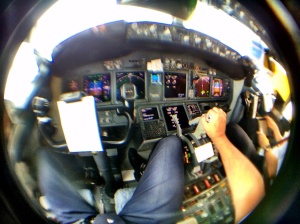So you want to become a pilot …
So, you’ve decided that being a pilot might suit you and you’re embarking on flying lessons. Good for you. Here are some off-the-books lessons I’ll share with you based on my 20,000 hours as a pilot. You probably won’t read these elsewhere because they’re not the typical media hype nor the hobbyist pilot bravado. But these lessons are fundamental to your understanding of the pilot world you propose enter.
1. Expect resistance, both from within and without. First, from without: your family and friends are concerned about you and any risks you might take. They probably haven’t considered flying as you have, evaluating the risks and benefits, and many have either never thought about becoming a pilot themselves, or did think about it and decided against learning to fly. Also, there’s the expense, in both dollars and time.
Flying lessons require a lot of both and those around you may resist losing that time with you, plus they may be negative about you committing to flying the time and budget that will necessarily limit your ability to do things like go out or vacation with them (are YOU ready to switch your budget priorities?) and also, force you to rearrange your free time schedule.
Parents and partners particularly may worry about the risks (remember, they haven’t been educated about the admirable safety record of general aviation as you have) as well as the expense, which is significant, especially given that you don’t know yourself yet if flying really suits you.
All of that external resistance is understandable and rather than becoming frustrated, become an educator: explain the safety record of such faithful and timeless standards as the Cessna 150 or 172 or whatever you’re flying. Describe the incremental steps of a flight training syllabus with a qualified instructor. Yes, there’s a significant financial commitment required and no, you’re not certain that the cost will be borne out by a lifetime in aviation. Nonetheless, you’re now at a point where finding out makes sense, and you can simply walk away at any point if you find that flying doesn’t suit you.
Internal resistance? That’s YOU. How good are you at the disciplined pursuit of a longterm goal, which proficiency as a pilot certainly requires for as long as you intend to fly? Recurring, never-ending demands of ratings, physicals, and training lie ahead–is that a challenge you typically embrace? Do you follow through on your plans, especially those requiring the consistent grunt work being a decent pilot demands?
There’s more. Physically, your body is entering a foreign environment of new challenges, from new and unfamiliar motor requirements of three dimensional movement to the vestibular sensations of movement in three axes. As one of my profs at the USC Flight Safety Center liked to say, no matter what cosmic jet we fly, we’re still just a “basic two mile per hour human,” physically evolved to walk on land–not fly.
Don’t let that stop you, or even slow you down: you’ll likely feel inept, maybe klutzy, your first few hours at the controls but that’s normal–we all go through that because you’re transcending the thousands of years of evolution and learning new reflexes and unnatural physical response. Give yourself a break. Don’t judge the entire pilot experience by the early struggles because they will smooth out with time.
2. Once you start flying, DON’T fly in your head. Let me explain: do your headwork BEFORE flight–learn the procedures and subjects pertinent to your aircraft and area. In flight, GET OUT OF YOUR HEAD and fly, period. The knowledge is still there for you to call upon, but the more important lessons are to be had physically: pay attention to the flight, what is actually happening versus what you expected or what you were told.
We don’t fly in books, tapes, sim programs or DVDs–we do it in the sky, in the weather, the wind and ambient conditions. That’s where your air sense is forged.
Don’t get me wrong: be obsessive about your preflight prep–devour pertinent training materials, study, memorize and review. In USAF Flight School, we called it “chair flying:” we’d physically talk through and do the hand motions required to effect each maneuver on the syllabus for a particular flight. That’s to forge patterned thinking and muscle memory, two things key to the physical performance required in the air. Sounds silly? Did you know the USAF Thunderbirds do exactly that as a group, in their preflight briefing room? That’s because muscle memory is key to successful flight maneuvers. This will boost your learning as well as your performance. Reinforce this concept on the ground, study, learn, review, practice.
In the air–fly. Get out of your head, trusting that if you’ve studied and reviewed hard enough beforehand, it’s all still crammed onto your cerebral hard drive, ready to be called on from the background. In the foreground: FTFA (Fly The F*cking Airplane) which simple as it sounds, is not always easy to focus on. Which brings me to point #3.
3. The aircraft is your best teacher. Sure, you’ve read the materials, studied, and you have an instructor talking in your ear through every new maneuver. Still, what’s the airplane telling you through your hands, feet, and its response? If you try to correct things based on books or talk, even from your instructor, give priority to what the aircraft is telling and showing you. I didn’t say ignore the rest, just prioritize the actual flight results.
Even now as a captain with thirty years at the world’s largest airline, I see copilots mystified by why some formula they use for descent or intercepts is not working out in realtime. I have only one answer: FTFA. Because I don’t know or care what component of the complex mix of time, speed, distance and altitude is screwing any formula, because again, we don’t fly on paper–we fly in the living, breathing, ever-changing sky in a unique aircraft that resists the one-size-fits-all mentality of formulas and gouges.
Same with your flight training: know the procedures and processes cold (study, review ON THE GROUND), listen to your instructor, but first and foremost, FTFA–feel what it’s telling you, then you fly IT, not vice versa–whatever it takes, aileron, rudder, elevator–DO IT.
4. Finally, a word about consistency. In an undertaking like flight lessons, DO NOT underestimate the powerful force of consistency in all matters, from the aircraft to instructor to airport, environment and even flight time. Minimize changes to all of these key factors in order to maximize your learning and developmental skills. As important, minimize training gaps, especially when you’re just developing the required physical adaptation and muscle memory flight training demands. Even now, if I take a two week vacation, I’m a little rusty on my first flight back. When you’re just learning, training gaps will only add to your frustration and slow your learning.
My T-38 instructor pilot told me the Air Force could teach a monkey to fly if they had enough bananas. His point was, they don’t–and neither do you: flying is expensive in both dollars and time. Keep the above points in mind to get the most out of your flight training and to make the endeavor as smooth and enjoyable as possible. Your family and friends will come around, accepting your flight endeavors as you successfully solo and progress steadily toward your pilot rating.
The rest is up to you. Welcome to the pilot world–and as we say to each other, fly safe and, I always add, fly smart.
✈️ Chris Manno






July 3, 2015 at 12:44 pm
we are for after pilot in last world. thanks
July 3, 2015 at 12:55 pm
[…] So you want to become a pilot …. […]
July 3, 2015 at 1:52 pm
Ho-boy, concur!
July 3, 2015 at 2:26 pm
Thanks for a wonderful, most enlightened post, Chris. I agree that students won’t find this material in their books or even hear most of it from their CFI. All points are important, but IMO the most important item, essential to becoming a Good Pilot is embedded in point four. The student pilot to take two or three lessons and then does not fly for ~three months, can be expected to lose >50% of his/her recent gains. Stick with it to reinforce that which has just been learned!
As always, your pix are great. Image #1, the airport air shot of DFW I’m guessing, I one of the best that I’ve ever seen. Regards,
-Craig
July 3, 2015 at 3:41 pm
Yes, the value of consistency can’t be overestimated. Even in my end of the flying biz, the management pilots stay “qualified” by flying now and then, but “proficient” is a different thing that comes from frequency.
July 7, 2015 at 7:49 pm
Never better said.
-C.
July 3, 2015 at 5:59 pm
Thank you for a great post, even if it was 20 years late.
I wish I had this advice before starting my flying way back when. It would have made the process a lot more fun (it was still a lot of fun!) and I would have become a better pilot. I have been grounded for the last five years at the age of 50 due to a medical with no real hope of ever returning so I have sent this to my son in hope it will rekindle his interest in flying. He started his PPL work, but stopped when I was grounded. I told him I can think of no better words to give him should he ever decide to return to flying, which I urged him to do.
Thanks again for another great post. I can almost hear the wheels coming up….
July 3, 2015 at 6:05 pm
Must have gone through UPT at Willy (monkeys/bananas comment). I received the same one.
July 3, 2015 at 6:06 pm
Heck no–that’s where all the Zoomies went. I was in special Ed at Reese by the Sea.
July 3, 2015 at 6:24 pm
Reblogged this on keithpeers247.
July 4, 2015 at 9:02 am
I must say, after reading this it does bring backyard childhood dreams of being s pilot.
Thanks.
July 4, 2015 at 10:26 am
Reblogged this on variusevanssingapore.
July 4, 2015 at 10:26 am
[…] So you want to become a pilot …. […]
July 4, 2015 at 10:36 am
Love the third and last pictures of the sky. Views in the sky you can never get tired of and that are always different.
Found the second topic really interesting.
July 5, 2015 at 12:17 am
I gave up flying due to cost (it got to the point where I had to chose between eating and flying however only one will keep you alive), and the fact that I get violently airsick on small aircraft to the point where I’m effectively incapacitated but strangely enough I don’t experience any problems on airliners even when flying near turbulent storms. Thanks to a few enthusiastic mechanics I’ve discovered the joy of maintenance and engineering plus given my technical aptitude it turns out that I’m enjoying the mx field a lot more than I ever did flying. However to all the aspiring pilots, mechanics, engineers, flight attendants, firefighters, etc remember you only have one life to live, do not let others dictate that life for you and pursue YOUR dreams.
July 7, 2015 at 7:55 pm
Great reply, @Alex. All the noted professions are needed in aviation and not everyone is built to be the driver. Mx is most worthy and and only the best need apply. Nice to hear that you’ve found a comfortable home. -Craig
July 8, 2015 at 4:59 pm
Yea I’m in school right now to earn the A&P and videos on youtube are great motivational tools, it’s awesome watching mechanics in Dubai replace the vertical stabilizer on an A330 or watch a BA 747 get it’s cabin stripped to the frame during one of it’s D checks. Everyone in aviation has their niche.
July 5, 2015 at 5:12 pm
Capt. Chris,
Your advice is spot on. 25 years ago, I was taught how to fly by an ex-USN pilot. Some simple yet very wise advice has served me very well. He also subscribed to the aviate, navigate, communicate mantra. He also told me two things that really stuck with me, like you say, fly the plane, and that taking off was always an option, landing is not.
Good CFIs make good pilots. Thanks
July 8, 2015 at 5:03 pm
Will be interested what comments you have about the United glitch today. (Still shiver over the suggestion that planes in the air could be controlled by those on the ground “for safety”)
July 11, 2015 at 3:31 am
I haven’t flown for 30 years and miss it. I am friends with a retired 777 Captain and when I told him that flying was a curious mixture of freedom and discipline, he said that a psychiatrist studied it and said that it exercises both sides of the brain – the logic side and the artistic side.
I have flown with pilots who had the skills but bad judgement. I remember being with one in a 172, we are turning base to final at Wichita’s Mid Continent, and he was tight and banked 60 degrees to make the final approach. Low and slow and within a few knots of stalling and possibly spinning.
You have to be aware of a constantly changing environment and how it potentially affects you. You have to be humble when you realize sometimes even the best have had accidents because of too many overwhelming factors.
BTW he had a compliment to the 737 drivers – because many of them actually fly the plane more than the 747/777 transcontinental drivers.
July 13, 2015 at 4:35 pm
Hey – you’re in Roxie’s / Sunscribe’s Fall author teasers?
http://sunscribe.net/2015/07/12/whats-new-tempting-teasers/
July 13, 2015 at 4:46 pm
Yes–spring release planned for my novel, “East Jesus.”
August 4, 2015 at 8:01 pm
FTFA…. I have to remember that when it’s all going wrong….
Have you ever had to remember that while flying one of the big ones?
August 4, 2015 at 8:04 pm
Yeah, I’ve had to tell copilots before, “Never mind all that–just FTFA.” People get into their heads too much at times of high stress, forget we’re moving at 300 knots across the ground, close to the ground. Just fly it, worry about stuff later.